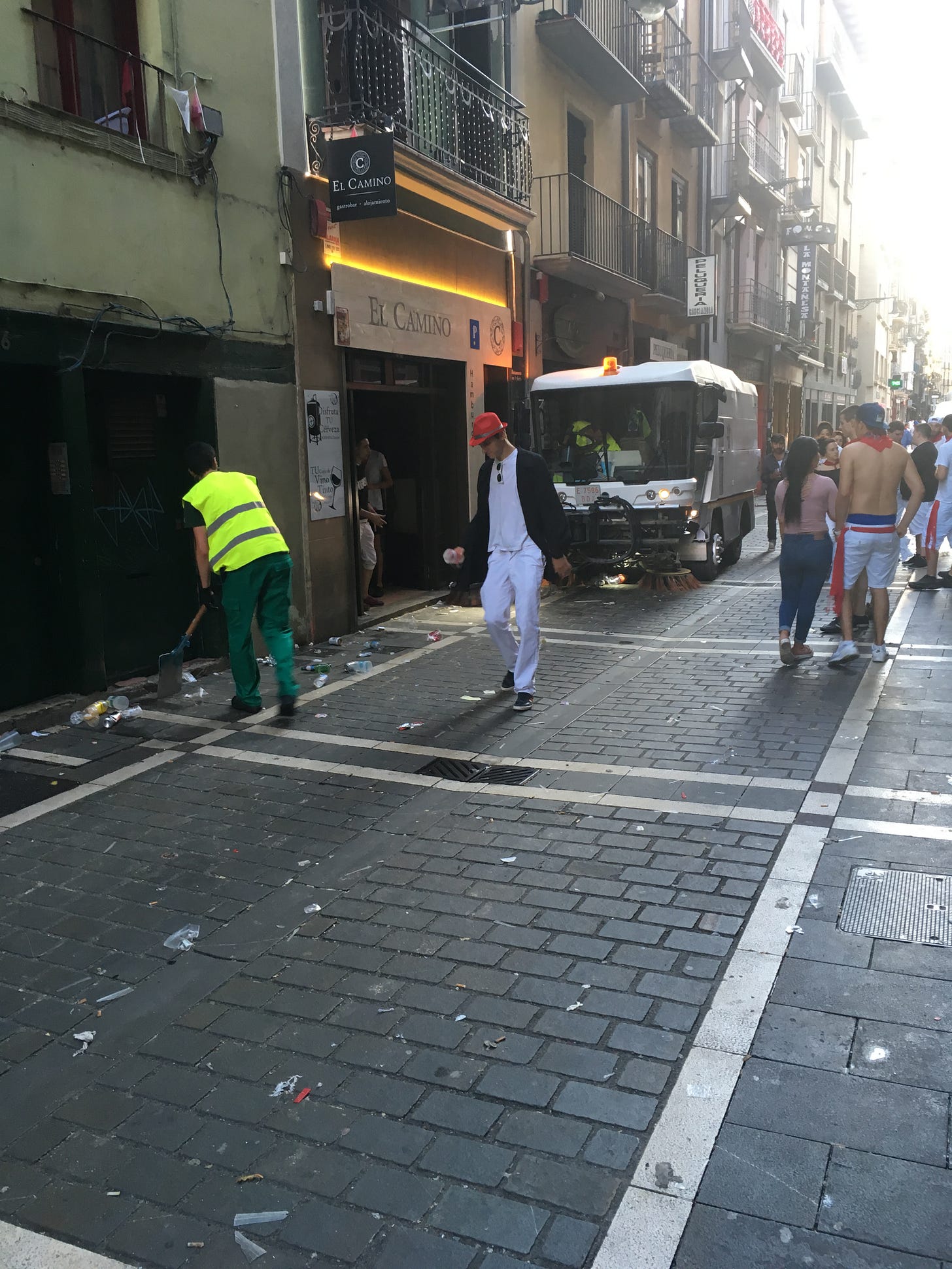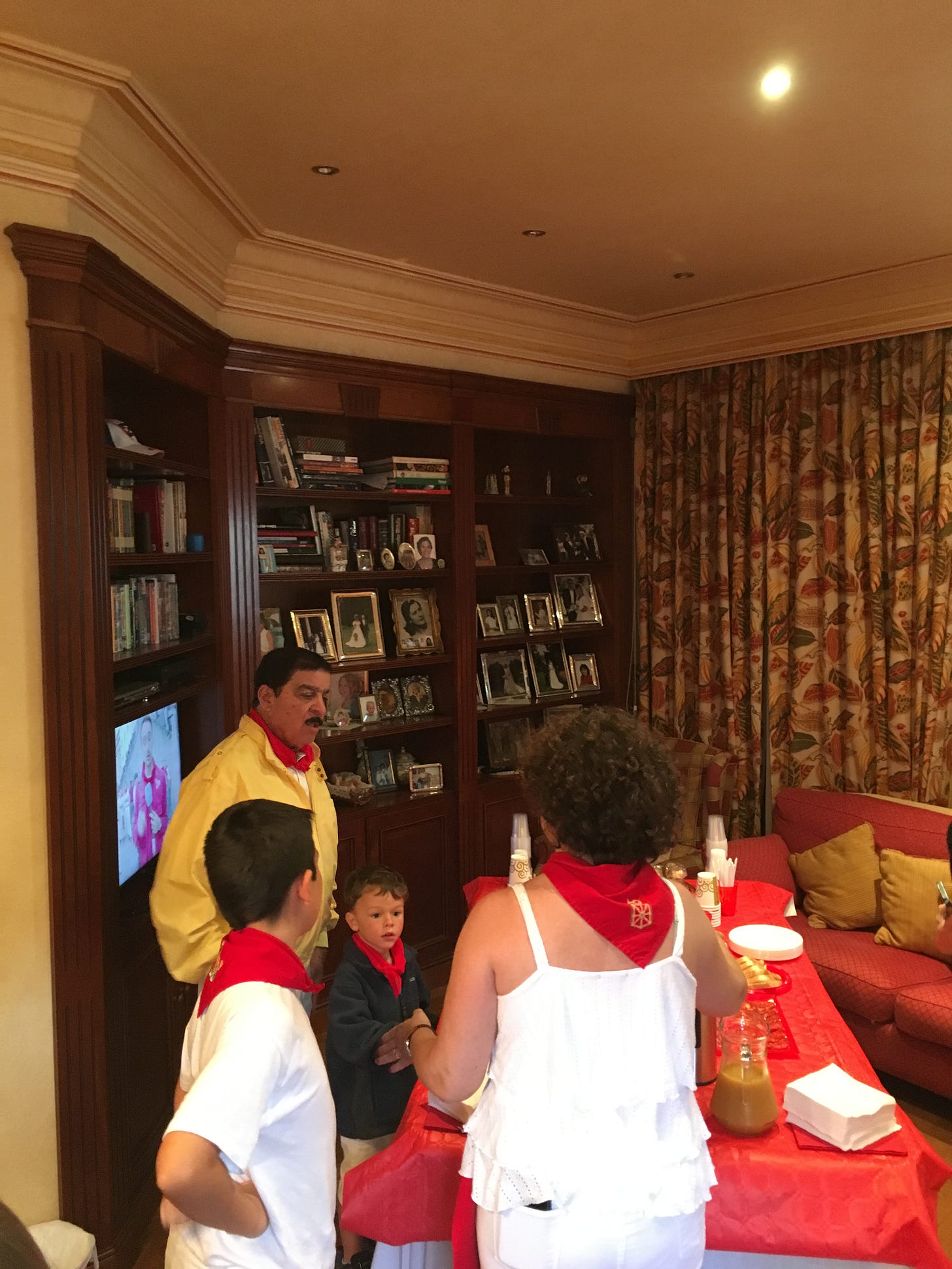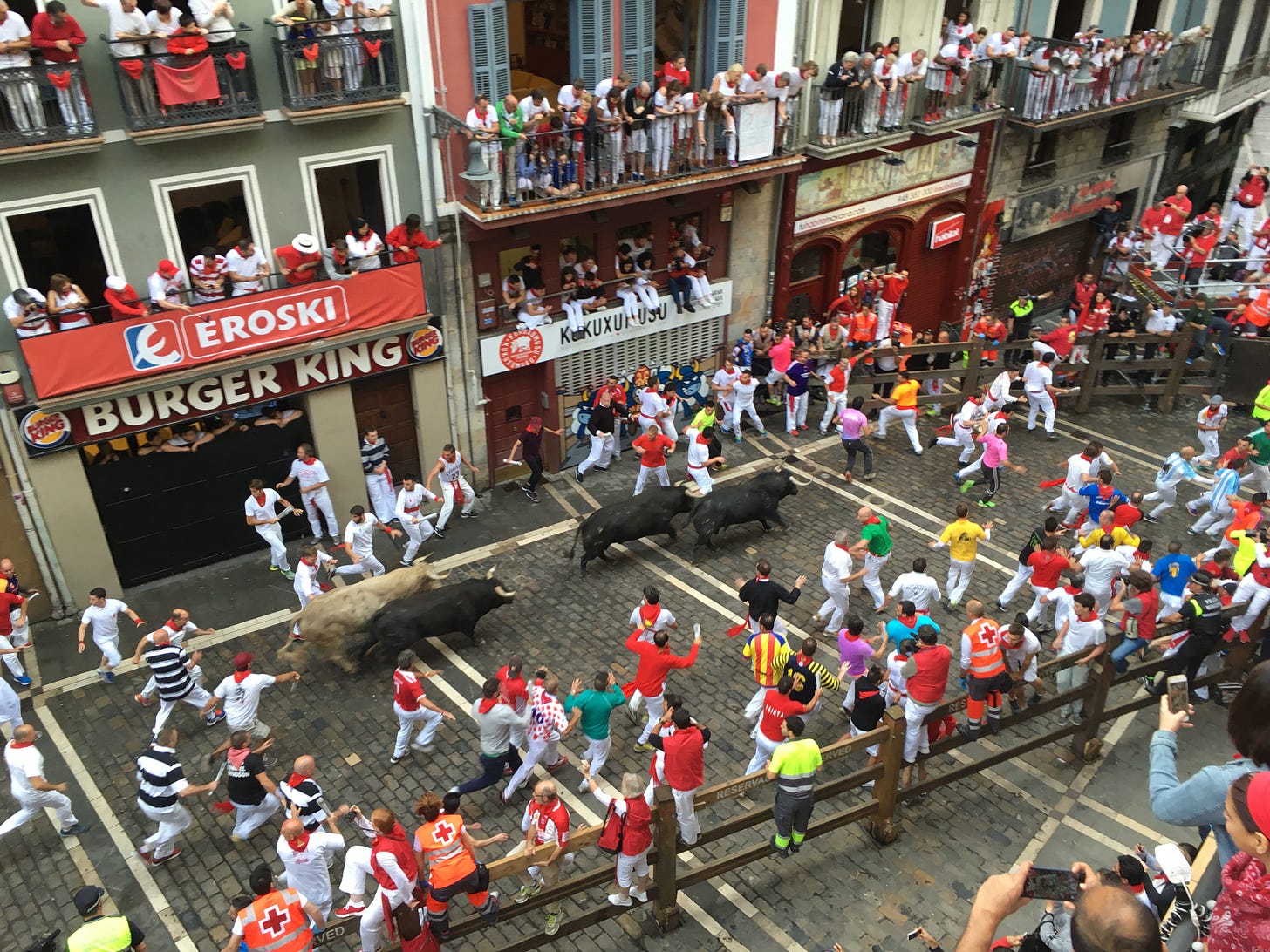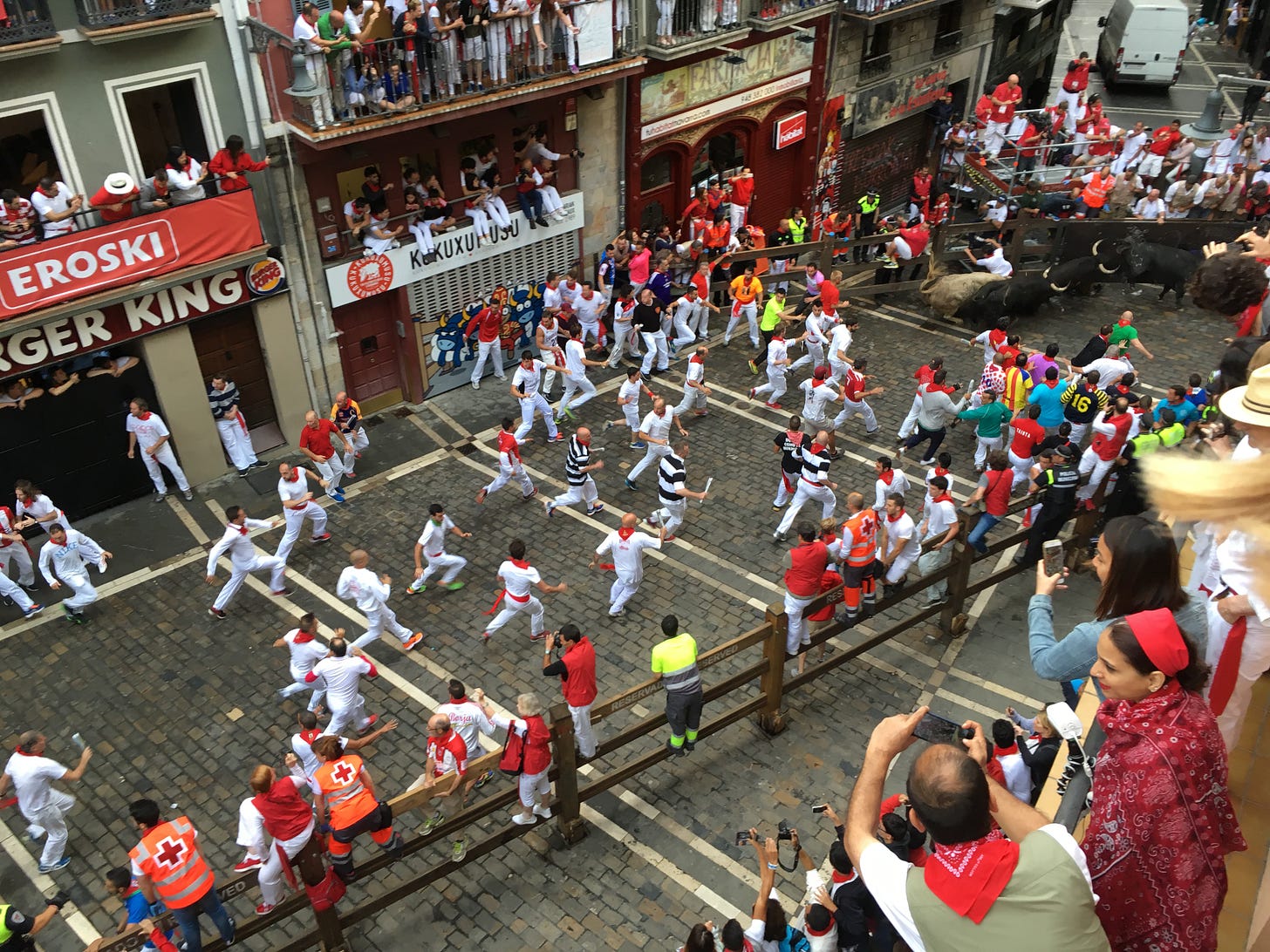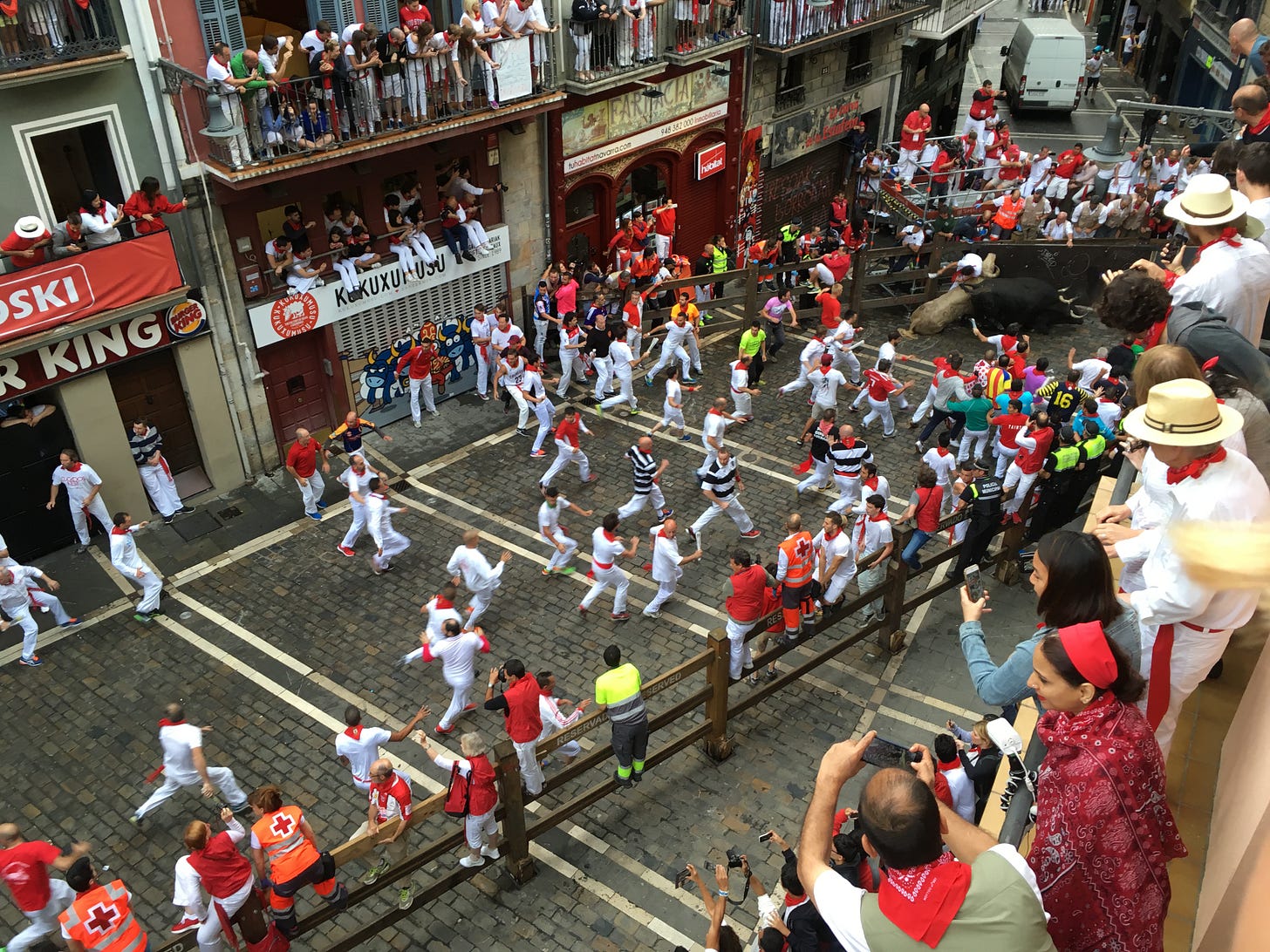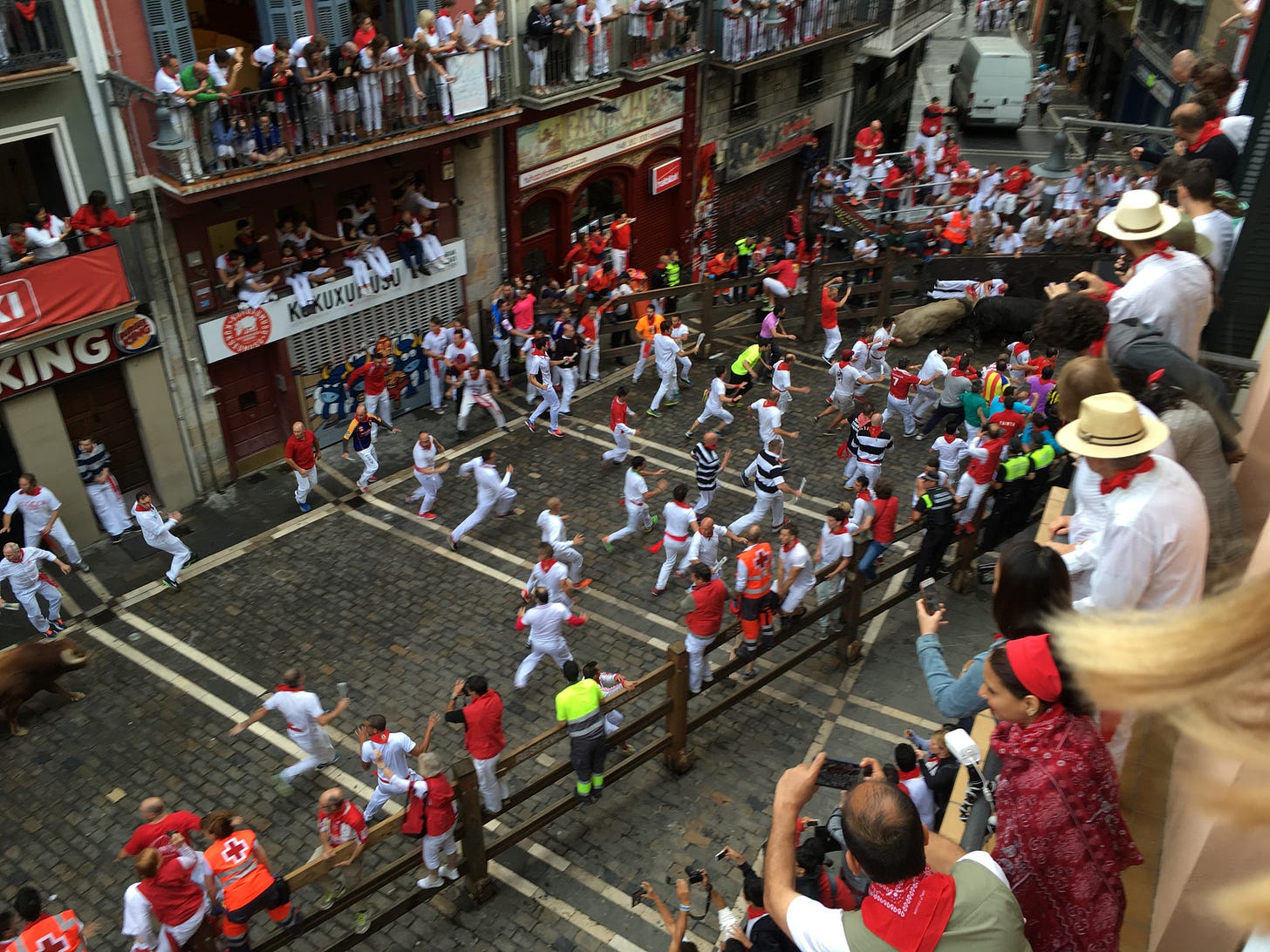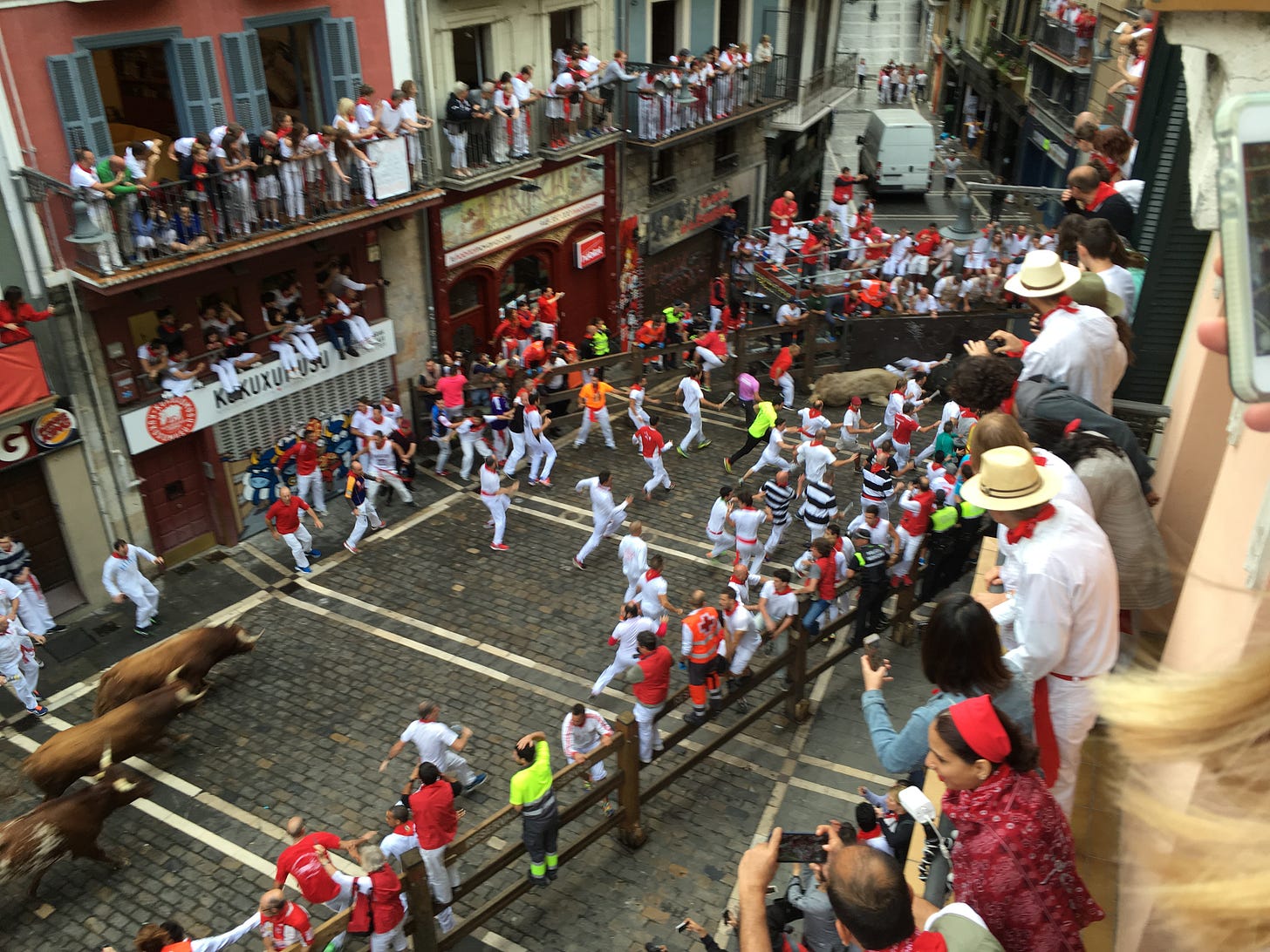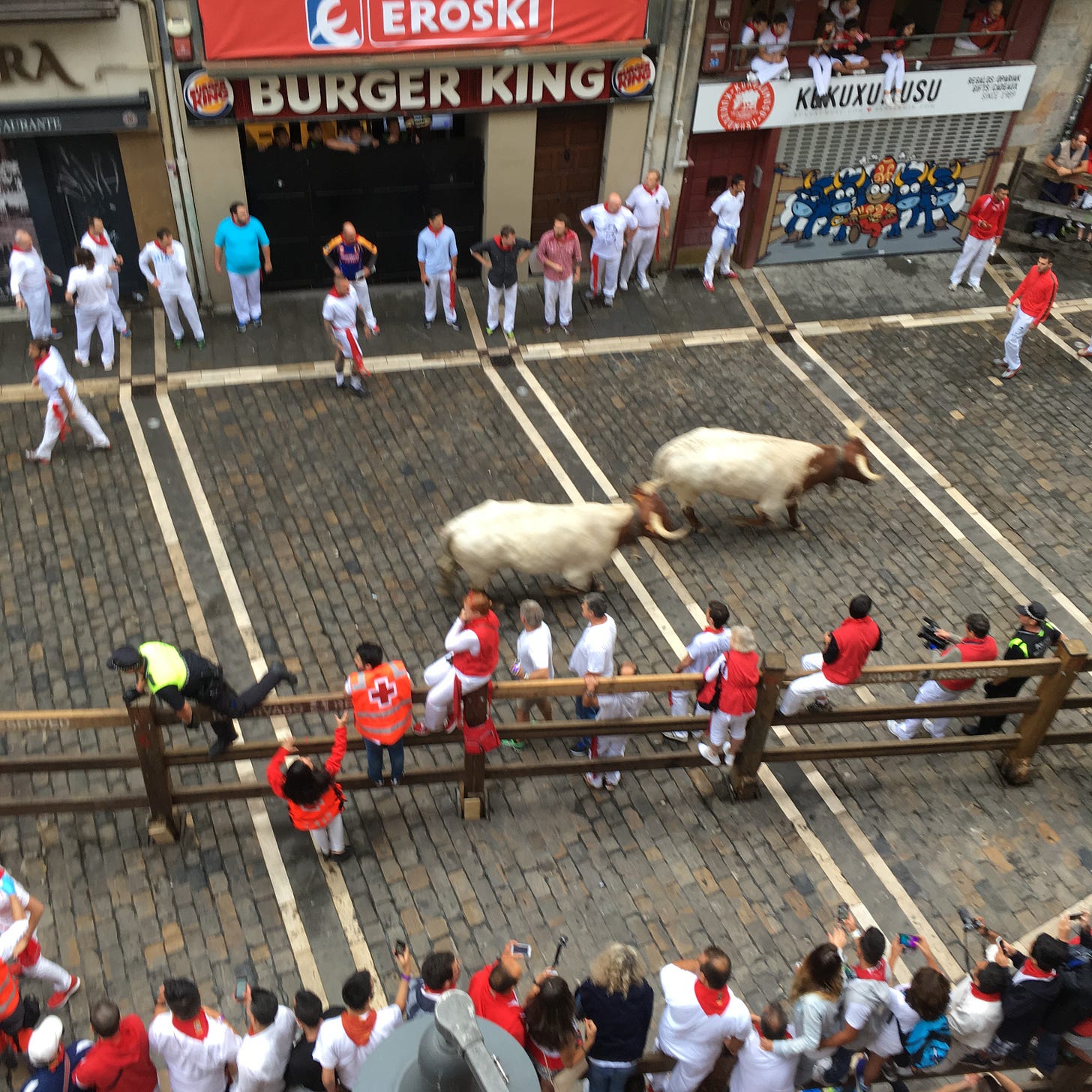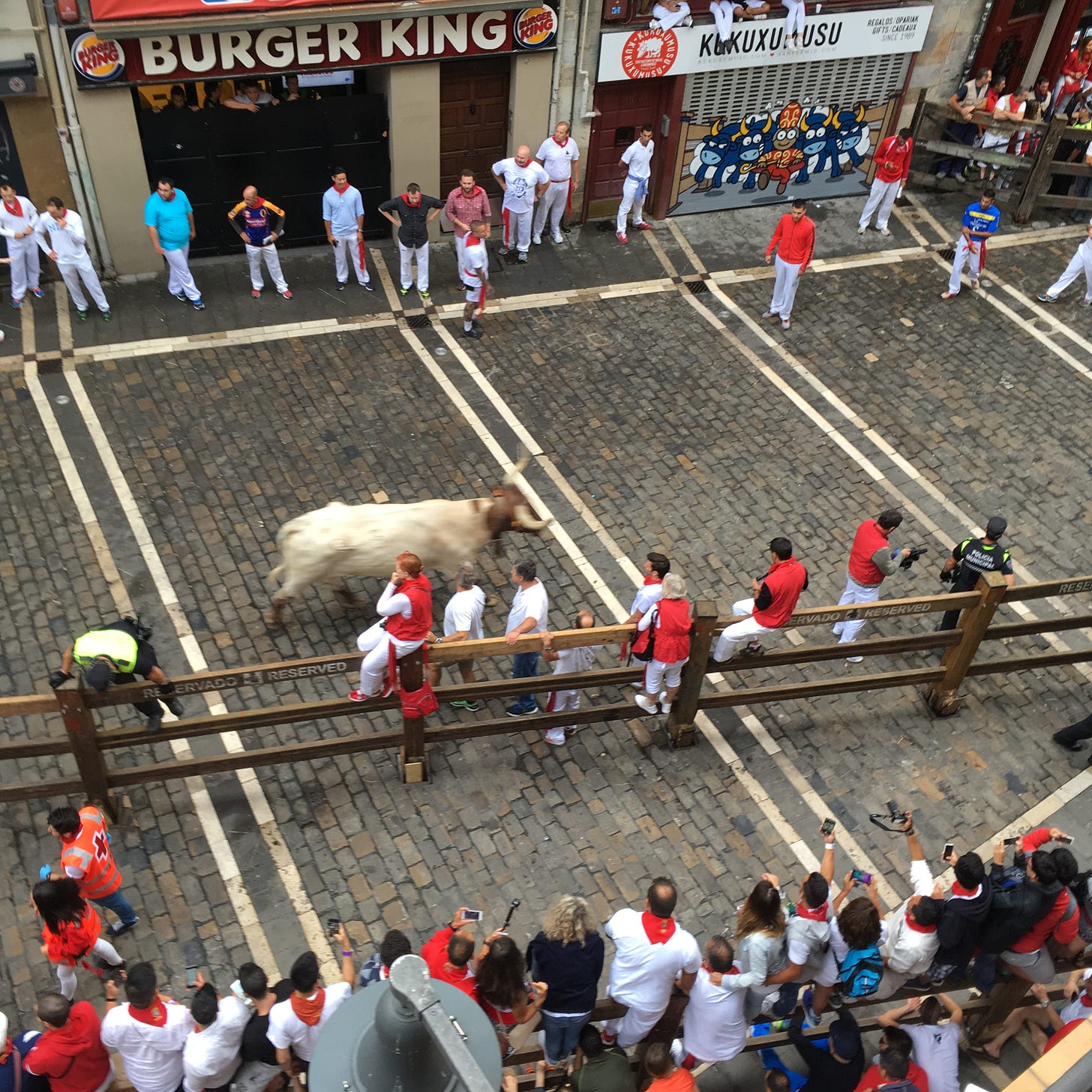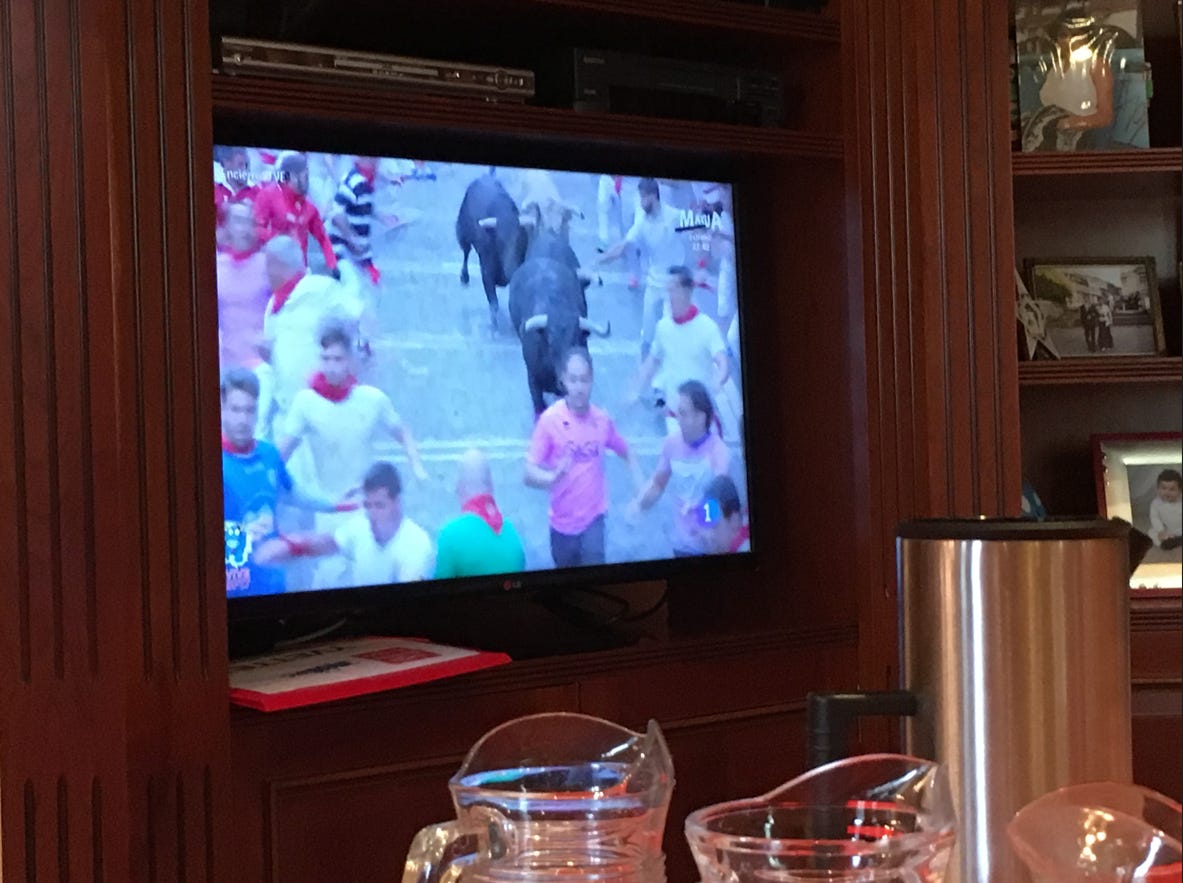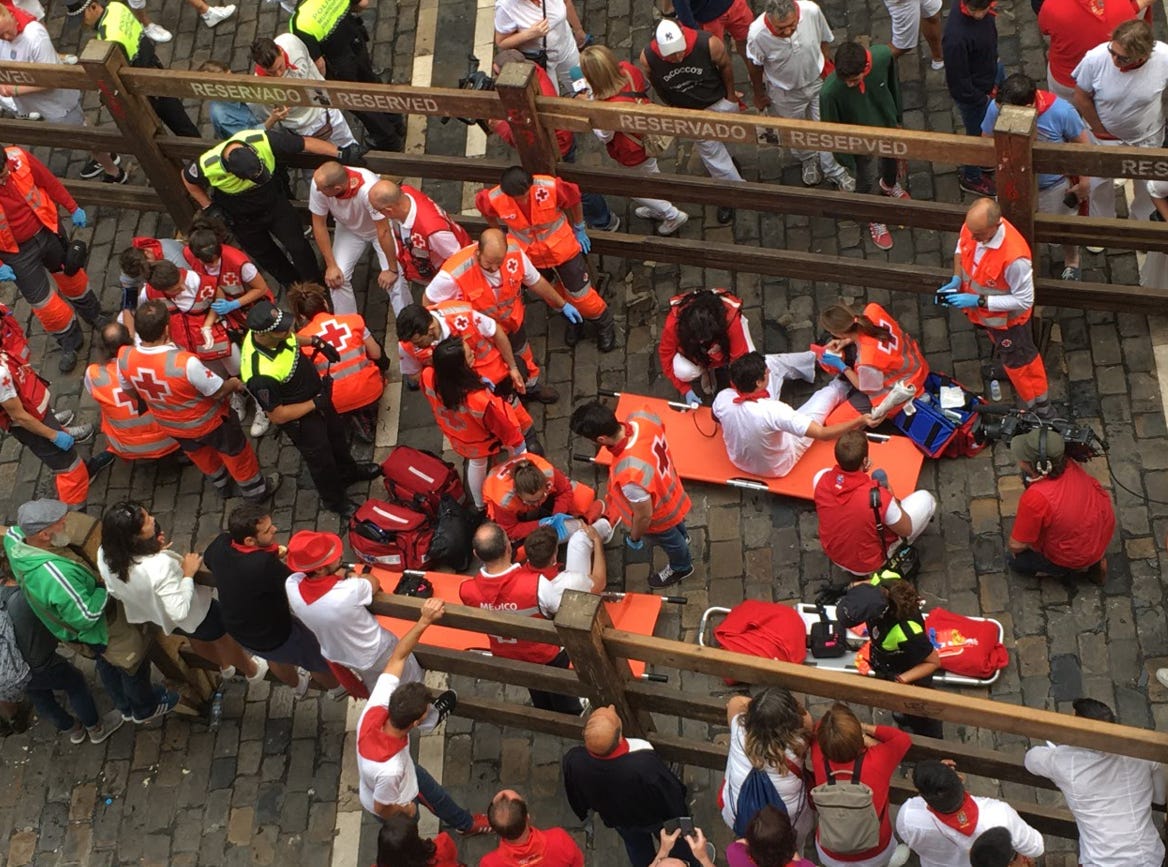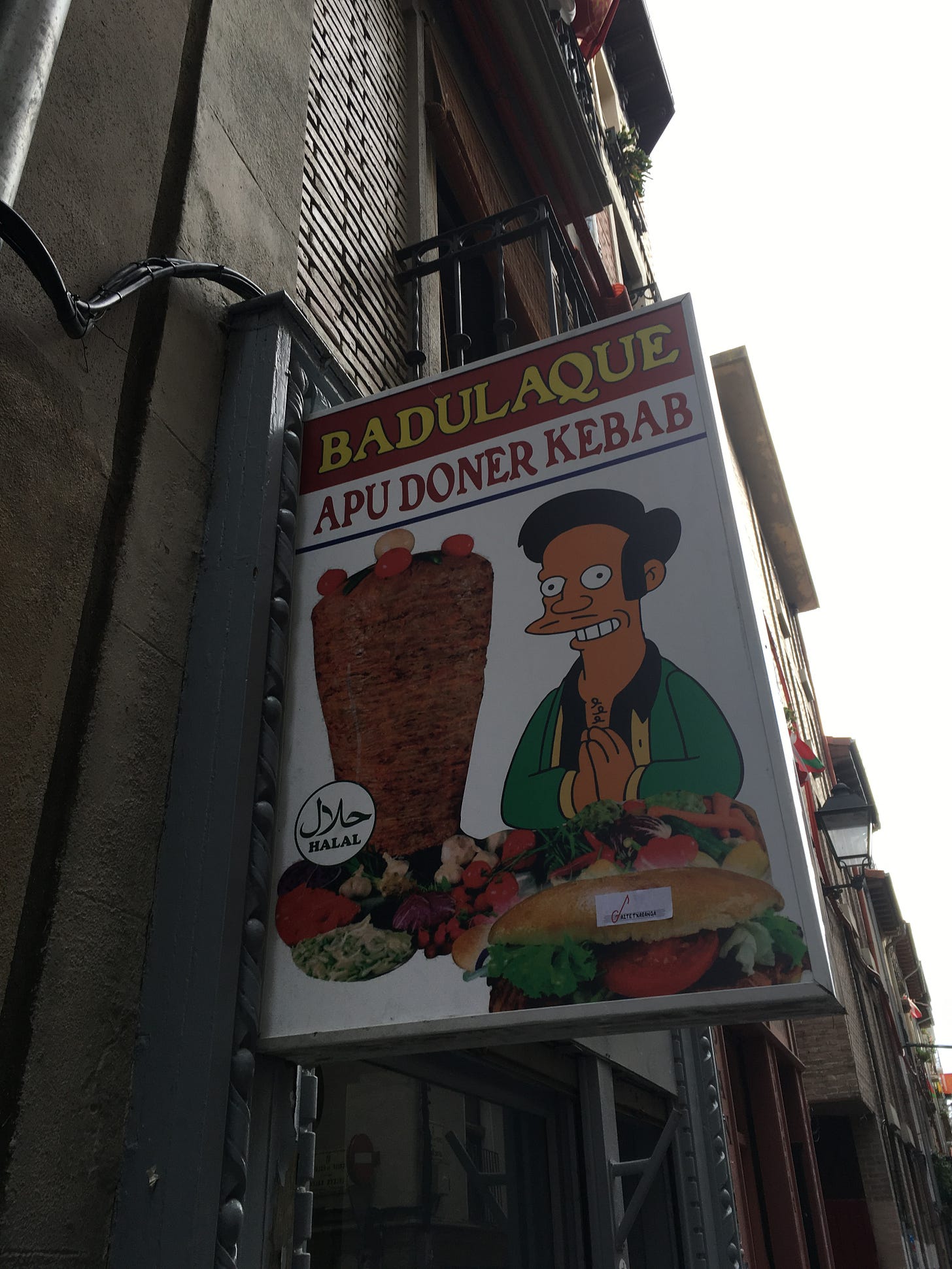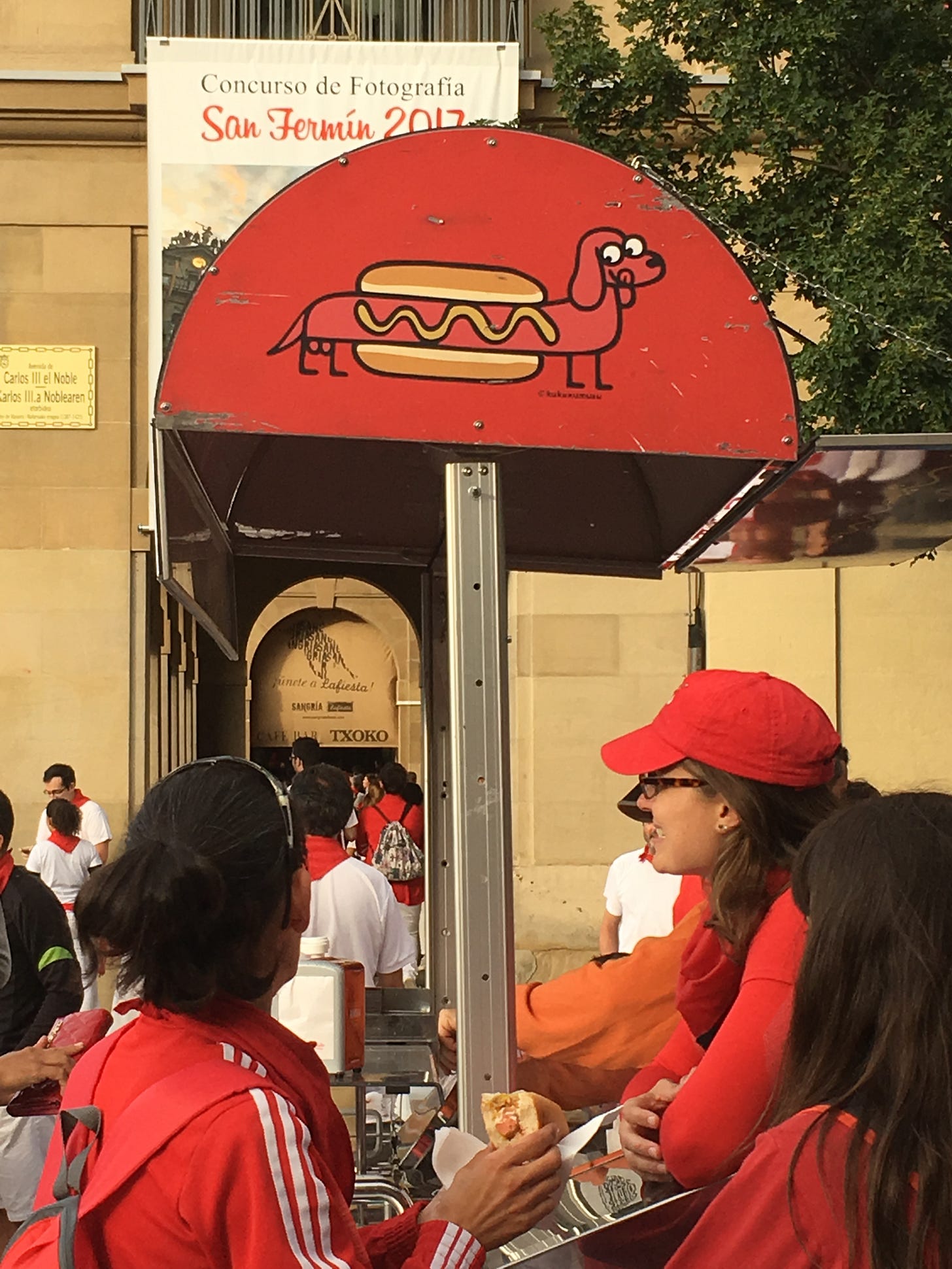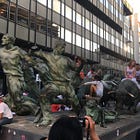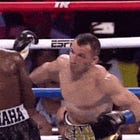Toros & Tubas: The Running of the Bulls
Disclaimer: This story has pictures and descriptions that may make some people uncomfortable.
“‘Could you bet on bullfights?’
‘You could,’ Bill said, ‘but you don't need to.’
‘It would be like betting on the war,’ I said. ‘You don't need any economic interest.’”1
-Ernest Hemingway
We got up around 6:30AM. My body ached from the 7.7 miles we walked the day prior. And the 13 miles the day before that. And the 86.9 miles we had walked the 10 days before that. The frantic pace we had been vacationing at wasn’t conducive to 6:30 AM wake-up calls, but if there's one thing to get you out of bed it's the knowledge that today is the day you're going to witness the Running of the Bulls. Our balcony check-in time was 7:30 AM and only a few blocks from where we were staying. The sky was dark and the streets were calm when we shut the large wooden door behind us and locked it with a primitive key. For the first time since arriving in Pamplona, the streets were not alive with licentiousness. In its place, was a team of street cleaners— spraying down the streets with hoses from a water truck. The hose man worked his device like a leaf blower, spraying all the beer bottles, food wrappers, and vomit into the sides of alleyways while another worker in a yellow vest swept the wreckage into the path of a compact streetsweeper van. They were doing a good job. Despite wet shoes, we followed the clean streets to the doorway along Calle Mercaderes that we discovered the previous afternoon. The next steps were unclear, but a white American woman with curly blonde hair introduced herself in perfect Midwestern English and asked for our names. Yvette found our names on a list. When you’re vacationing in a foreign country, it's always reassuring to see your name on a list.
We followed Yvette up the stairs to a second floor apartment where we would be watching the morning’s festivities. We weren't alone. Yvette seemed to be running the show and would break into perfect Spanish from side-conversation to side-conversation. She pointed to an elderly man seated silently in a recliner with a brood of Spaniards watching the local news coverage of the encierro.
“This is his apartment.”
He gave us a little wave and a slight nod. He was happy we were there, I’m sure this was a profitable morning for him.
A family member greeted us warmly and directed us to a collection of pastries and carafes on the kitchen table. We helped ourselves while Yvette introduced us to her other charges for the morning. A family from upstate New York with three young boys would be sharing the balcony with us, and another couple with a baby would be one window bay down with the apartment owner’s family. We chatted with our balcony mates, realizing they were the kind of people that had the financial resources to take three kids between the ages of 6 and 11 to the Pamplona for a family vacation. My parents took us to the Mall of America and Uncle Jim's house growing up.
Calle Mercaders was filling with runners, mostly young men, all wearing the same white shirts and red bandanas that we ourselves had on. Each runner seemed to have their own pre-game routine. Stretching. Jumping. Standing petrified in place. Dead Man's Corner was in full view, Paige heard a rumor they used to grease the intersection to make the collisions more dramatic but had stopped since 6 bulls and 6 steers chasing pedestrians at full speed and attempting a 90-degree turn was good enough. Ambulances parked in alleyways and paramedics were loading out stretchers in advance—preparing for the inevitable.
Yvette came to check on us and asked about our plans for the rest of our time in Pamplona. We casually mentioned we had talked about going to a bullfight, but understood it was impossible to get tickets.
“Do you want tickets? I can get you tickets.”
Paige and I made eye contact. We had raised eyebrows and shrugged shoulders.
“Yes.”
Yvette said she would look into it, but right now there wasn't time. The Running of the Bulls was about to begin.
“As in all arts the enjoyment increases with the knowledge of the art, but people will know the first time they go, if they go open-mindedly and only feel those things they actually feel and not the things they think they should feel, whether they will care for the bullfights or not."2
- Ernest Hemingway
Our view down the street was obstructed by a bicycle shop— we had to use context clues to get a sense of where the bulls were. Two fireworks fired, the first indicates that a bull left the corral on the other side of town, and the second signals that the last has followed the stampede. We heard both from the balcony. Runners stood erect, hands on hips, staring down Calle Mercaderes for their Minotaur. Then we saw movement. The most cautious started in a casual jog, joined by a few more, and then a few more, and then a torrent of men— bursting from a spigot like a water balloon breaking in the process of filling it. Three black bulls led the way followed by a single brown with the number “33” branded into his torso.
Runners were ducking to the sides, but real estate was scarce. Dead Man's Corner was approaching sooner than they had realized. Three men made the foolish decision to get caught, two avoiding the it horns of the lead bulls by jumping over the wooden barricade, but the last's split second of indecision proved his demise.
He avoided the lead bull by hugging the wooden fence.
But as he attempted to turn toward the other side, the second bull, running on the outside of the 90-degree turn, rammed his body straight into the barricade he was in the process of climbing.
He slipped.
The loss of footing delayed his salvation, allowing the last of the black bulls and brown number 33 to have their turns at abusing this curious target on the oddest day of their bull lives. He had both legs swept out from under him as his arms desperately clutched at the middle beam of the barricade. The black bull and number 33 lost their own footing as they attempted to make the turn into Estafeta, collapsing on top of one another with the runner landing on 33's horns. The brown bull didn't much appreciate this new barnacle. He thrust back his horns as he pulled his hooves splayed on the cobblestones back underneath his body. His legs now underneath him and his center of mass re-established, 33 used his full momentum to toss the runner upward as he clutched to the bull's horns. The runner rolled off the bull's back and laid motionless on the cobblestones as the trailing steers prompted 33 to move along and complete the turn. The runner’s static body disappeared as he was desperately pulled underneath a gap in the bottom of the barricade and out of the path of any additional wildlife.
A few steers trotted casually behind, the bells on their necks jangling to notify everyone that the caboose had arrived.
We heard a third firework, signaling that the first bull entered the corral at the end of the bull ring. And then a fourth.
All the bulls were where they were supposed to be. For now. The encierro was over in less than 3 minutes.
•••
“If there is any chance of (a first timer) liking the bullfights the best bullfight for him to see first is an average one, two brave bulls out of six, the four undistinguished ones to give relief to the performance of the two excellent ones, three bullfighters, not too highly paid, so that whatever extraordinary things they do will look difficult rather than easy, a seat not too near the ring so that he will see the entire spectacle… and a hot sunny day.”3
-Ernest Hemingway
We looked at our balcony mates. From now on we could all tell our friends, family, acquaintances, and annoying coworkers that insist on how interesting they are that we had seen the Running of the Bulls.
And so had their three young kids that were now making hooting noises as if they were playing Mario Kart while watching the replays of the race on the apartment TV. I hope they appreciated the moment as much as I appreciated the Paul Bunyan's Log Chute ride at the Mall of America.
Yvette was eager to make a good impression. When Paige made an off-hand comment on how efficient the whole experience was, Yvette doe-eyed Paige and asked if she would please repeat that exact compliment so she could record it on her iPhone. The two of them trotted off to a corner of the apartment with better lighting while I polished off another pastry and joined the boys watching slow motion replays of the dude that got his shit rocked by #33. When the girls returned, Yvette had an update for us. She had tracked down two bullfight tickets for that night through her elaborate network of Pamplonans eager to make money off tourists. And we were eager to give them our money.
Yvette led us out of the apartment and down Calle Mercaderes for several blocks—the barricades had been slid back to allow for pedestrian traffic— and we met another nondescript male with two flimsy pieces of parchment with a photo of a bull and a timestamp for that evening. Yvette had negotiated a price of 40 Euros per ticket, roughly double the face value, which decimated the remaining Euros we had on hand but was the most obvious purchase of our entire time in Europe. We thanked Yvette and the shady character, went our separate ways, and then Paige and I reworked the entire day's itinerary with this new knowledge.
We were going to a bullfight.
Despite the paramedics treating the less fortunate on stretchers, the party was picking back up. It wasn't quite mid-morning, but the first shift of partiers had just clocked in for a full day's work. It wasn't the free-for-all that the late afternoons and evenings were, meaning the bars were open but you could still walk through the streets without colliding into someone. We found sanctuary in a few different shops and souvenir stands, buying San Fermin wine, craft beer, and discovering that the official names of the San Fermin mascots were Mister Testis and Miss Tetis. As far as cartoon cattle go, they were very formal.
Lunch options were tricky. We had used all our petty cash on bullfight tickets and to order food you had to yell in Spanish over the backs of a mob surrounding a counter with beers in hand. But despite their challenges, the Pamplona restaurants made up for it with amazing names, names that probably came across a little differently to a predominantly Spanish speaking populace but certainly captured the attention of the English tourists.
Every morning of the festival, right after the adults get chased by violent farm animals, the kids get chased by ugly paper mâché people with foam maces. Over 150 years ago, artists created four enormous paper mâché costumes representing a king and queen from Europe, Asia, America, and Africa. They are each around 13 feet tall, and they do a little dance and twirl around as people life them up and down with the gigantic dowels running down their paper mâché spinal columns. But at some point, Pamplona decided to do what Pamplona does best, and inject a little fear and danger into the tradition.
Travelling to the world’s most famous Spanish festival with a high school Spanish teacher that teaches in depth Spanish culture lessons means that I had my personal tour guide throughout the trip, This came in handy when on our way back to the hotel a man with a horse outfit ran me down and whacked the shit out of the back of my neck with a foam weapon. They call it “La comparsa de gigantes y cabezudos,” which translates to, “the parade of giants and big heads.” It's a good name, but they forgot to mention the beating the shit out of you with a foam club part. They keep that a fun surprise.
With a full stomach and a back full of fresh welts, Paige and I retreated to our Air BnB for a 3-hour nap. We had— again— seen some of the most amazing things in our lifetime, but we needed some rest before we topped it all later that evening.
To Be Continued.
The Sun Also Rises by Ernest Hemingway, pg. 91
Death in the Afternoon by Ernest Hemingway, pg.10
Ibid, pg. 103



